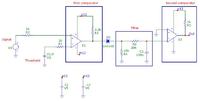abuhafss
Full Member level 2
Hi
I need to compare a square wave signal with a reference voltage (11.90v).
In condition A, the sq. wave fluctuates between 11.89 and 12.00v which means the reference voltage falls within the range of the square wave.
In condition B, the sq. wave fluctuates between 11.95 and 12.00v which means the reference voltage is below the range of square wave.
I want to compare in such a way that I get 12v at the output of the comparator LM393 for condition A and 0v for condition B.
The supply voltage is 12v and the frequency of the sq. wave is about 1.4Hz.
Thanks in advance for the help.
I need to compare a square wave signal with a reference voltage (11.90v).
In condition A, the sq. wave fluctuates between 11.89 and 12.00v which means the reference voltage falls within the range of the square wave.
In condition B, the sq. wave fluctuates between 11.95 and 12.00v which means the reference voltage is below the range of square wave.
I want to compare in such a way that I get 12v at the output of the comparator LM393 for condition A and 0v for condition B.
The supply voltage is 12v and the frequency of the sq. wave is about 1.4Hz.
Thanks in advance for the help.


